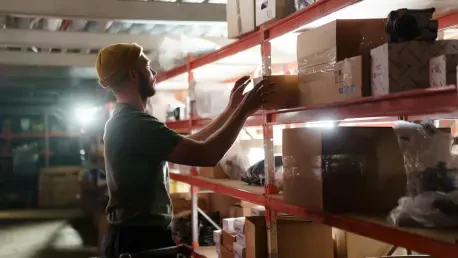I’m thrilled to sit down with Marco Gaietti, a veteran in business management with decades of experience in strategic operations and intralogistics. Today, we’re diving into the transformative journey of Portwest, a leading online workwear company, as they revolutionized their distribution center in Barnsley, UK, with a cutting-edge automated storage and retrieval system (AS/RS). Marco will share insights on the motivations behind this shift, the incredible impact on productivity, and how automation can harmonize with workforce growth. We’ll explore the operational efficiencies gained, the technology’s standout features, and the broader implications for customer satisfaction and industry standards.
How did Portwest come to the decision to transition from a completely manual fulfillment process to an automated system at their Barnsley distribution center?
Portwest faced significant limitations with their manual fulfillment process that simply couldn’t keep pace with their rapid growth. Handling just 30 boxes per hour was labor-intensive and inefficient, creating bottlenecks as demand for their workwear products surged. The decision to automate wasn’t just about speed—it was about scalability and staying competitive in a fast-moving market. After evaluating their operational pain points, they saw automation as the key to unlocking capacity and ensuring they could meet customer expectations without compromising quality.
What kind of impact has this new AS/RS system had on productivity at the Barnsley facility?
The impact has been nothing short of remarkable. With the new system, Portwest has boosted their output to 300 boxes per hour—a tenfold increase from their manual days. Beyond raw numbers, the automation has streamlined workflows, reduced physical strain on workers, and allowed the team to focus on more strategic tasks. It’s not just about doing more; it’s about doing it smarter, with fewer errors and greater consistency across the operation.
Can you paint a picture of what this tenfold productivity increase looks like in the day-to-day operations at Portwest?
Absolutely. Imagine a warehouse that once struggled to process a small batch of orders in an hour now handling hundreds seamlessly. On the floor, this means teams are no longer bogged down by repetitive manual tasks—instead, they’re managing systems, overseeing quality checks, and handling exceptions. High-demand items like high-viz jackets and safety gloves move through the system much faster, ensuring orders are fulfilled and shipped without delay. It’s transformed the pace and rhythm of the entire facility.
Automation often sparks worries about job cuts. How did Portwest manage this transition without any redundancies?
Portwest approached automation with a clear commitment to their people. From the start, the goal wasn’t to replace workers but to empower them with better tools. They retrained staff to operate and maintain the new system, creating more engaging and skilled roles. Employees who once spent hours on manual picking now take on supervisory or technical positions, adding value in new ways. It’s a testament to how automation, when done thoughtfully, can drive growth while enriching the workforce.
With the significant reduction in mis-picks, how has this influenced customer satisfaction and overall service levels?
Reducing mis-picks has been a game-changer for customer satisfaction. When orders are accurate, customers trust the brand more—whether it’s a bulk shipment of PPE kits or a single safety glove order, they get exactly what they expect, on time. Feedback has been overwhelmingly positive, with clients noting faster delivery and fewer errors. Internally, Portwest tracks service levels through metrics like order accuracy and fulfillment speed, and the improvements are stark compared to the pre-automation era.
What are some of the standout features of this AS/RS system that have driven the biggest changes for Portwest?
The system’s design is incredibly innovative. The double-deep storage capability of the cranes allows for handling two cases at once, maximizing both storage space and throughput. Then there’s the high-density racking with over 76,000 unique locations, which has more than doubled their handling capacity. These features ensure that even at peak demand, the system can store and retrieve products efficiently, keeping operations smooth and responsive to customer needs.
How do you see the role of automation evolving in the intralogistics space, based on Portwest’s experience?
Portwest’s journey shows that automation is not just a trend—it’s becoming the backbone of modern intralogistics. It’s evolving to be more integrated, with systems that communicate seamlessly with existing software and adapt to specific business needs. I believe we’ll see more companies adopting hybrid models, blending automation with human expertise to balance efficiency and flexibility. The focus will also shift toward sustainability, with systems designed to cut energy use and optimize space, much like the advancements we’ve seen in this setup.
What’s your forecast for the future of warehouse automation in the coming years?
I’m optimistic about the trajectory of warehouse automation. Over the next decade, I expect to see even smarter systems powered by AI and machine learning, predicting demand patterns and optimizing inventory in real-time. Robotics will become more accessible and affordable, allowing smaller businesses to automate. Sustainability will also drive innovation—think energy-efficient cranes and eco-friendly materials in warehouse design. Ultimately, automation will continue to transform how we think about logistics, making operations faster, greener, and more resilient to market shifts.









